Snakes have many different associations for many different people. The biblical story of a cunning serpent who tricked Eve in the Garden of Eden has inspired centuries of allegories and metaphors that connect snakes to lies, deceit, and temptation. Vipers are often connected with evil and death because of their toxic venom and large fangs. However, snakes are also a symbol of rebirth, renewal, and regeneration, because they shed their old skin. Many people have a fear of snakes, while countless others keep snakes as pets, and some even see them as beloved companions.
Humans have been fascinated with snakes since the beginning of time. Snakes feature in stories throughout the ages, whether in history, world mythologies, and even pop culture and today’s media. Let’s take a look at 20 of the most famous snakes, from those in the Bible to characters in Harry Potter.
1. Adam, Eve, and The Bible

According to the Book of Genesis, “The serpent was more subtle than any beast of the field (…)”
©wjarek/Shutterstock.com
Possibly one of the world’s most famous snakes comes from the biblical story of the serpent in the Garden of Eden. According to the Book of Genesis from the Old Testament, the first humans on earth, Adam and Eve, originally lived in the Garden of Eden. Although the garden was their own private paradise, Adam and Eve were forbidden to eat any of the fruit produced by the “Tree of Knowledge”. However, a serpent, or snake, tempted Eve and convinced her to eat the fruit. He told her that if she did, the fruit would open her eyes to knowledge, and she would become like God.
Biblical scholars and historians argue as to whether the serpent in this story was an actual physical snake, an allegory, or the devil himself in disguise. Whatever the true meaning behind this serpent is, it has inspired fear and mistrust of snakes for centuries and remains a powerful symbol of temptation, sin, and manipulation today.
2. Biblical Serpents and Moses

The “fiery” serpents in the Bible refer to the painful burning caused by a viper’s venomous bite.
©Morphart Creation/Shutterstock.com
Although the serpent in the garden can symbolize evil and cunning, other biblical snakes are associated with renewal, power, and healing. For example, Moses and Aaron go to the Pharaoh of Egypt hoping he will release the Israelites. Aaron throws down his staff and God turns it into a serpent to manifest his power. Pharaoh’s magicians create their own serpents, but Aaron’s rod-turned-snake quickly devours them.
After the Israelites escape their slavery in Egypt, they begin to complain so God sends fiery serpents to attack them. Moses then raises a staff crowned with a bronze snake, and the Israelites need only to look at it to be healed.
3. The Epic of Gilgamesh
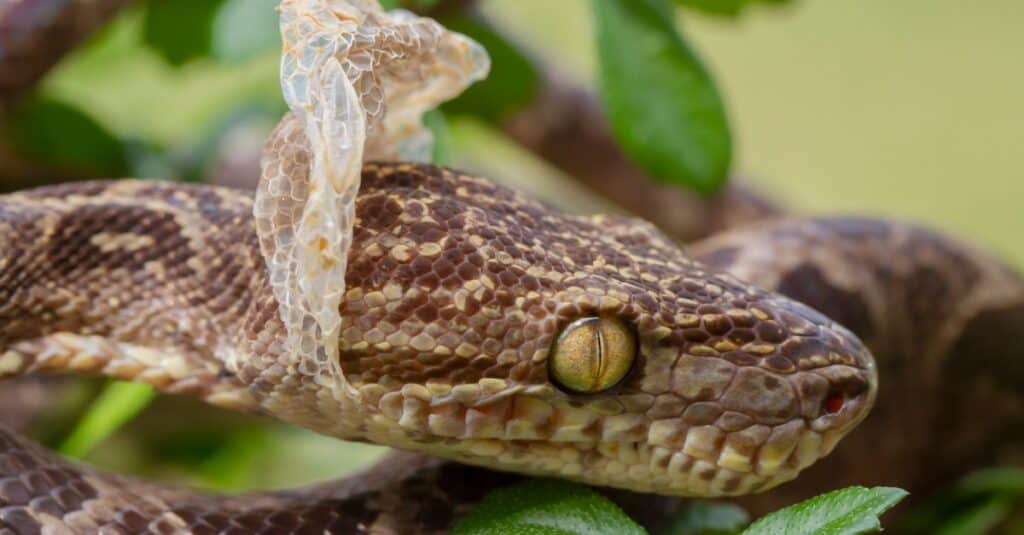
According to the
Epic of Gilgamesh, snakes are able to shed their skin due to the stolen plant.
©iStock.com/Mark Kostich
The snake in the Epic of Gilgamesh is not necessarily “good” or “bad”. Instead, the snake in this ancient Mesopotamian story seems to remind us that we all will die someday, no matter how hard we try to avoid it. Gilgamesh, the story’s hero, is completely devasted when his best friend, Enkidu, is killed. To avoid the same fate for himself, Gilgamesh embarks on a quest to find a plant that can give him immortality. Gilgamesh obtains the plant, but a snake steals it when his back is turned.
4. The Rainbow Snake

are extinct snakes in Australia that are possibly the origin of “The Rainbow Snake.”
©Alpha from Melbourne, Australia / Creative Commons – License
The story of the Rainbow Snake illustrates renewal and rebirth. When anthropologists noticed that a giant snake was the main character of several stories of the aboriginal peoples of Australia, they called it “The Rainbow Snake”. Although there are many different variations of the story, each tells of a creator god who came to Australia in the form of a large serpent, the “Rainbow Snake”. As the Rainbow Snake slithered across the land, his body tore through the earth. This created valleys, rivers, and streams, which the Rainbow Snake filled with water.
5. Medusa
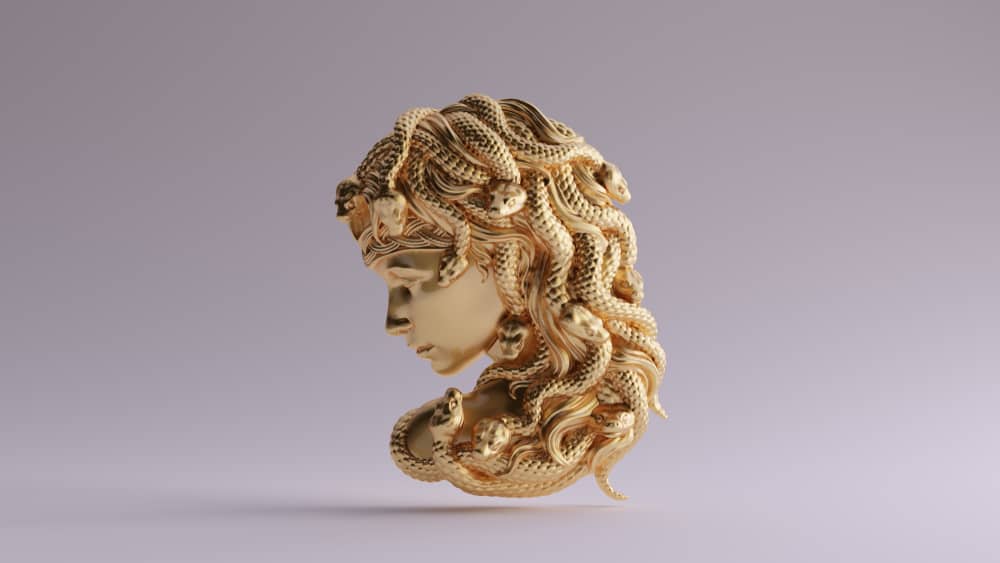
The Gorgon Medusa had venomous snakes growing out of her head instead of hair.
© 80’s Child/Shutterstock.com
One of the most famous snakes from Greek mythology is the gorgon, Medusa. “Gorgon” comes from a Greek word that means “grim,” “terrible,” or “fierce,” which is a good description of these monstrous creatures. Gorgons were fierce women that had snakes in place of hair, spat poison, and could turn humans to stone with a single look.
Early tales of Medusa say that she was born as a gorgon, but later stories claim that she was once a mortal human being. These myths explain that Athena transformed Medusa into a gorgon as a punishment, or to protect her from the lusts of men. Interestingly, Medusa’s name comes from a Greek word that means “to protect” or “to guard”.
Although she was fierce and powerful, Medusa was eventually killed by the Greek hero Perseus. When Perseus beheaded Medusa, the famous winged horse, Pegasus, was born from her neck. Even in death, however, Medusa’s snake covered head held the power to turn mortals into stone, so Perseus eventually gave it to Athena. Athena placed the head on her shield, and it became one of her godly identifying symbols.
6. The Hydra
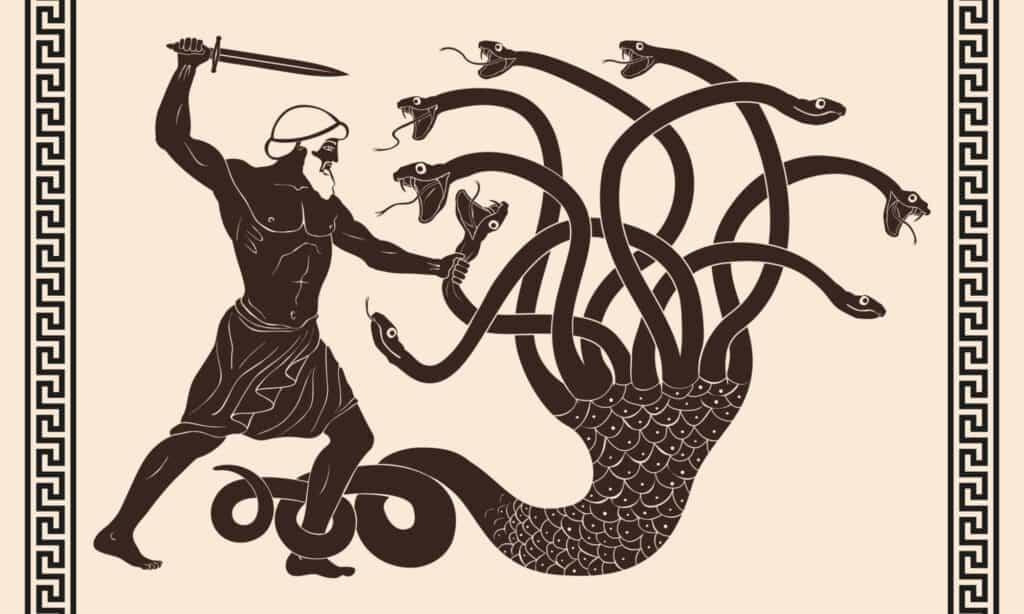
In Ancient Greek mythology, the hydra’s snake heads continually regenerated after being chopped off.
©Hoika Mikhail/Shutterstock.com
Ancient Greek mythology tells another story of one of the most famous snakes in history, the frightening serpent-like Hydra. The Hydra was a water monster with several snake-like heads. The number of heads differs depending on the story. However, in many of the myths, when one snakehead was cut off, two more grew back in its place. As one of his 12 labors, Heracles killed the Hydra, which was then placed in the sky as a starry constellation.
7. The Medical Symbol of the Caduceus

Originally Hermes’ Caduceus staff symbolized negotiation, wisdom, alchemy, thieves, and trade.
©Natykach Nataliia/Shutterstock.com
Because snakes shed their skin, they are also a symbol of renewal, rebirth, and regeneration. Asclepius, the Greek god of medicine, carried a serpent-entwined staff, as did Hermes, the messenger god. Actually, Hermes had two snakes on his staff, along with a pair of wings. Over the centuries these two symbolic staffs became enmeshed so that today they are often seen as the same symbol. Hermes’ staff, the “Caduceus”, is commonly used in the medical field as a symbol of healing.
8. Jörmungandr: The World Serpent

Jörmungandr is fated to kill the god Thor during the final battle of Ragnarök.
©Dotted Yeti/Shutterstock.com
The snakes of Norse Mythology are often symbols of destruction, chaos, and transformation. One of the most famous snakes, Jörmungandr, also known as the “Midgard Serpent” or the “World Serpent”, is the child of the god Loki and the giantess Angrboða. This giant snake is so large that his entire body encircles the world as he bites his own tail. Jörmungandr lives deep in the ocean where he waits for Ragnarök, the last battle of the gods.
9. The Horned Serpent

Horned serpents in Native American stories have powers like shapeshifting, hypnotism, and invisibility.
©iStock.com/Mark Kostich
Many Native American traditions tell stories of a horned serpent associated with water, rain, and storms. For the Muscogee people, for example, this snake lives underwater. Its body is covered with powerful crystals that can be used for divination and healing. In Arizona and New Mexico, the horned serpent Avanyu, is a guardian of water.
10. Quetzalcoatl: The Feathered Serpent

The quetzal is associated with the snake god Quetzalcoatl and seen as a symbol for goodness and light.
©clicksdemexico/Shutterstock.com
The feathered serpent god, Quetzalcoatl, is the most famous snake in South America and an important mediator for the ancient Toltecs and Aztecs. Quetzalcoatl was the connection between the immortal realm of the gods, and the mortal realm of humans. He had the body of a snake but was also covered in the vividly colored feathers of a Quetzal bird. The resplendent Quetzal is an important symbol in both Aztec and Mayan culture. Quetzalcoatl was a god associated with wind, sun, air, learning, death, life, and rebirth.
11. Nāga
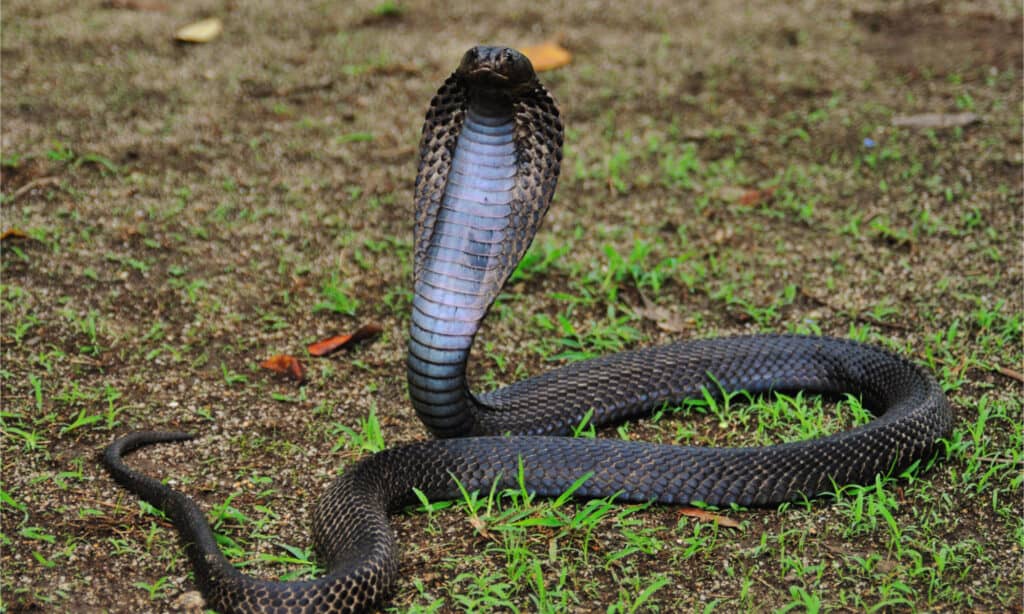
Nāga often took the form of a cobra.
©Reptilian/Shutterstock.com
Stories from Buddhism, Jainism, and Hinduism, often include the famous snake-like creatures called Nāga. Nāga were divine beings that were both human and snake. Like many mythological snakes, Nāga were neither good nor evil, but some combination of both. The snake king Muchalinda, for example, protected Buddha during a storm. Kāliya, on the other hand, poisoned a river until the god Krishna intervened and defeated him.
12. St. Patrick and the Snakes of Ireland
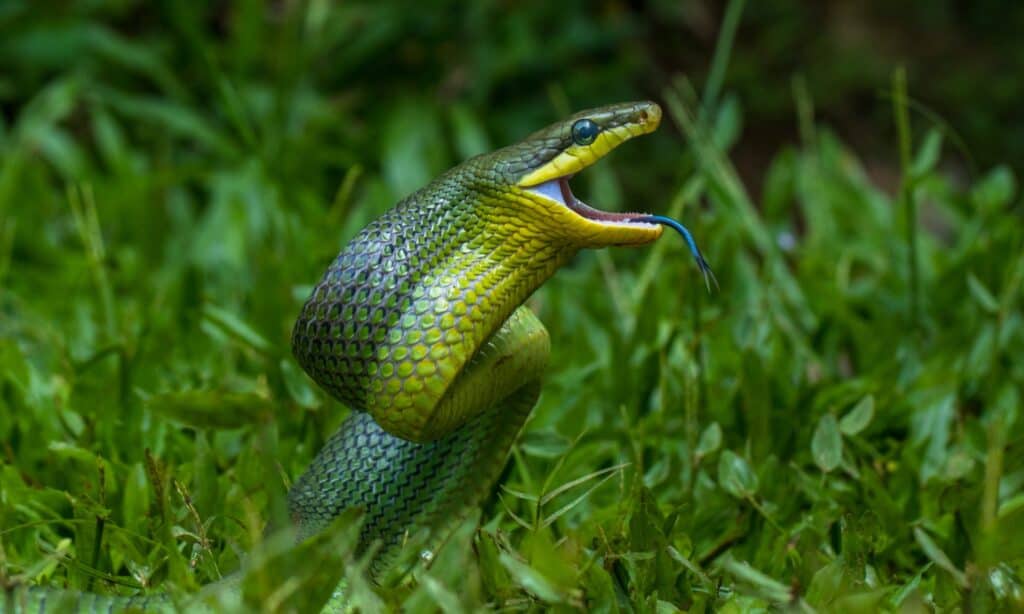
According to legend, St. Patrick chased snakes out of Ireland.
©iStock.com/LESSY SEBASTIAN
March 17 is about more than just lucky shamrocks and pots of gold. “St. Patrick’s Day” was actually named as a holiday to honor Ireland’s patron saint, St. Patrick. According to legend, in the 5th century St. Patrick used the power of God to chase all the snakes from Ireland into the sea. Perhaps this would explain why there are no snakes in Ireland today. However, according to archaeological evidence, snakes have never lived in Ireland.
13. The Legend of the White Snake
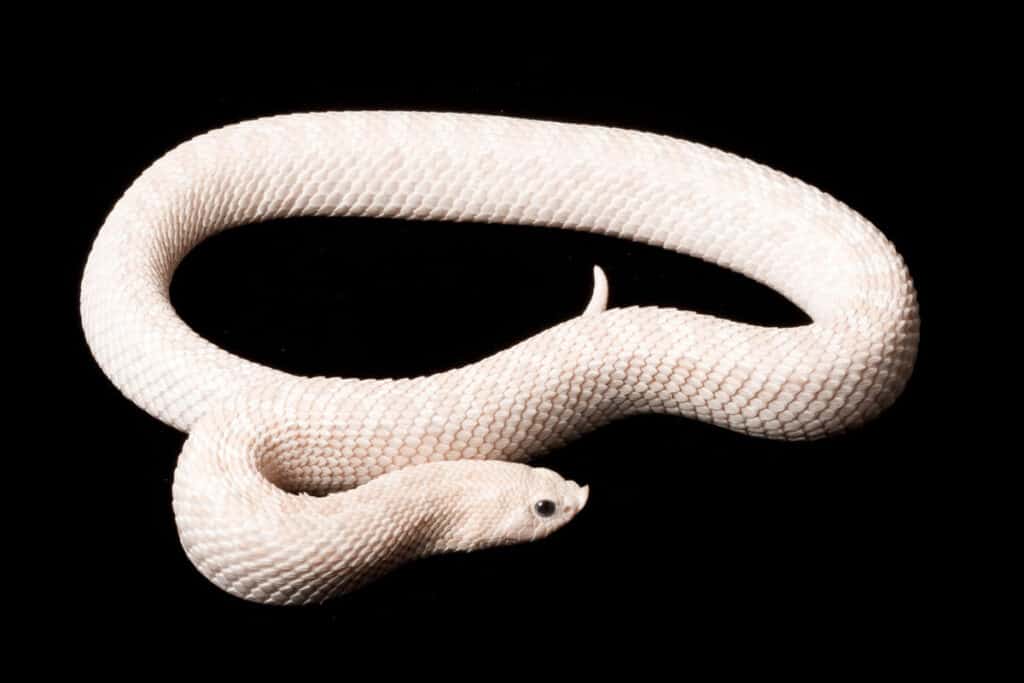
The Legend of the White Snake dates back as far as the Tang Dynasty in China (617-907).
©fivespots/Shutterstock.com
The Chinese Legend of the White Snake is one of China’s Four Great Folktales. This ancient tale of China’s most famous snake has been told and retold for centuries in various books, operas, television series, and films. The story recounts the life of an immortal snake spirit, Bai Suzhen, and a mortal man, Xu Xian. The two fell in love and were married, but eventually Bai’s true identity was revealed, and she was kidnapped. However, the two had a son together, and decades later, he frees his mother from her imprisonment.
14. The Jungle Book and Rikki-Tikki-Tavi
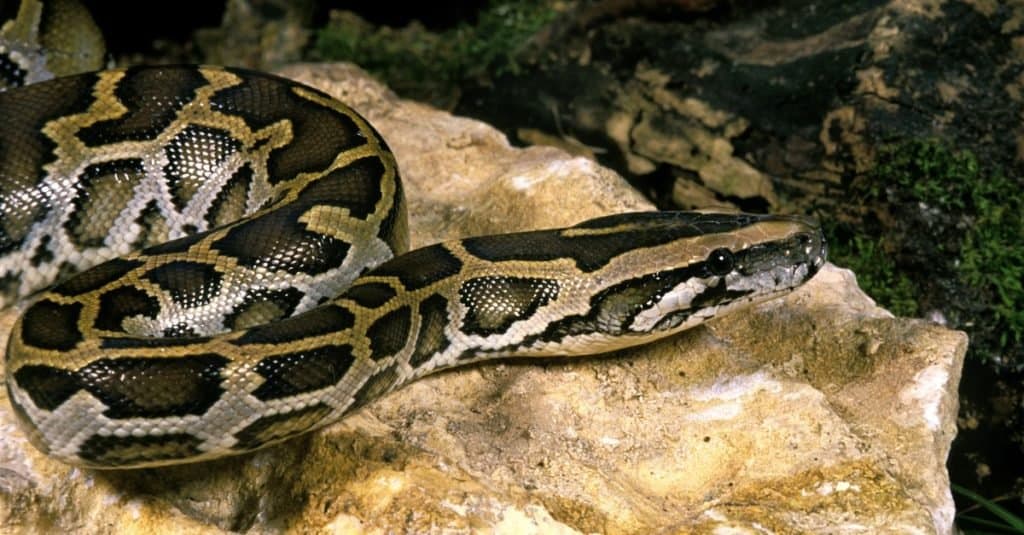
Kaa is a type of Indian Python, though according to Kipling, he is at least 100 years old.
©slowmotiongli/Shutterstock.com
Rudyard Kipling wrote several different animal stories that feature snakes. One of his most famous collections, The Jungle Book, includes the story of Mowgli, a young boy growing up in the jungle. One of Mowgli’s closest friends is Kaa, a 100-foot-long python. Hollywood commonly depicts Kaa as the villain of the story. However, in the original tale Kaa rescues Mowgli from the Bandar-log monkeys.
Rikki-Tikki-Tavi, one of Kipling’s short stories, also features a couple of famous snakes. In the story, an English family and their pet mongoose move to India. The problem, however, is that the resident king cobras in the area do not want humans invading their territory. Two of the cobras, Nag and Nagiana, attack the family’s home. However, the family’s pet mongoose, Rikki-Tikki-Tavi, defends the family and defeats the cobras.
15. Death by Snake: Cleopatra and the Asp

The asp is a long, venomous snake that can reach 3 feet in length. They have long, curved fangs.
©Matteo photos/Shutterstock.com
Although it does not make an appearance until the end of the play, the snake featured in William Shakespeare’s Antony and Cleopatra delivers quite a performance. In fact, without this snake, the dramatic climax of the story would not exist. After the Romans capture Cleopatra, she smuggles in a basket filled with fruit and a venomous asp. Cleopatra kills herself by allowing the dangerous viper to bite her: “With thy sharp teeth this knot intrinsic, of life at once untie…”
16. The Snake of the Chinese Zodiac

hose born in the year of the snake are said to be sophisticated, classy, smart, and quick-witted.
©iStock.com/sdbower
The snake is one of the twelve animals associated with each year in the Chinese Zodiac. According to legend, these twelve animals held a race to see who could cross the great river the fastest. The Snake knew he was not the fastest animal, but he wanted to try anyway. Using his talents of stealth and secrecy, the Snake hid on the hoof of the Horse as it crossed the great river. When the animals neared the finish line, the Snake revealed himself and scared the Horse so that he could finish the race first. In the end, the snake was the 6th animal to cross the finish line, with the Horse close behind in 7th place.
17. The Ouroboros

A snake biting its own tail is a symbol of continuity.
©Andrey Khusnutdinov/Shutterstock.com
The Ouroboros is a symbol that depicts a snake’s body looped in a circle as it consumes its own tail. The ancient Greeks and ancient Egyptians used this symbol for continuity and eternity, or an infinite cycle of beginnings and endings. Philosophers and scientists later used it as a symbol for alchemy, often when speaking of the Philosopher’s Stone. The Ouroboros also played a prominent role in the books and television series, The Discovery of Witches.
18. Anaconda
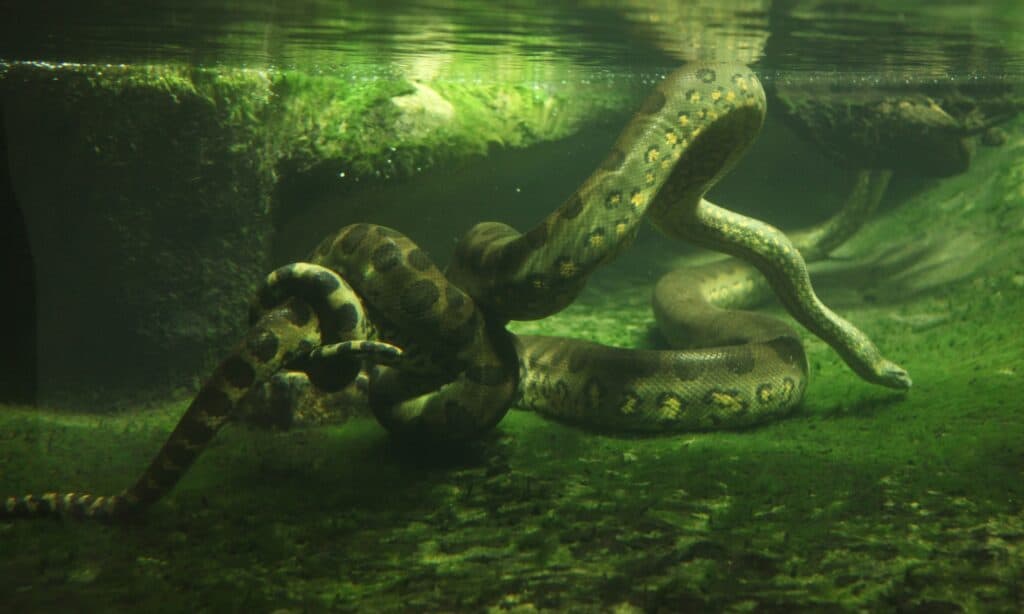
Green anaconda snakes may reach up to 30 feet long as adults.
©Vladimir Wrangel/Shutterstock.com
The famous antagonist of the 1997 film, Anaconda, is none other than a giant green anaconda in the Amazon rainforest. Although the film initially received negative reviews from critics, it became an economic success at the box office, making $136.8 million worldwide. Over the years Anaconda has also become a beloved “cult classic” film, demonstrating that humans are still fascinated by snakes—especially really big ones.
19. Harry Potter Talks to Snakes
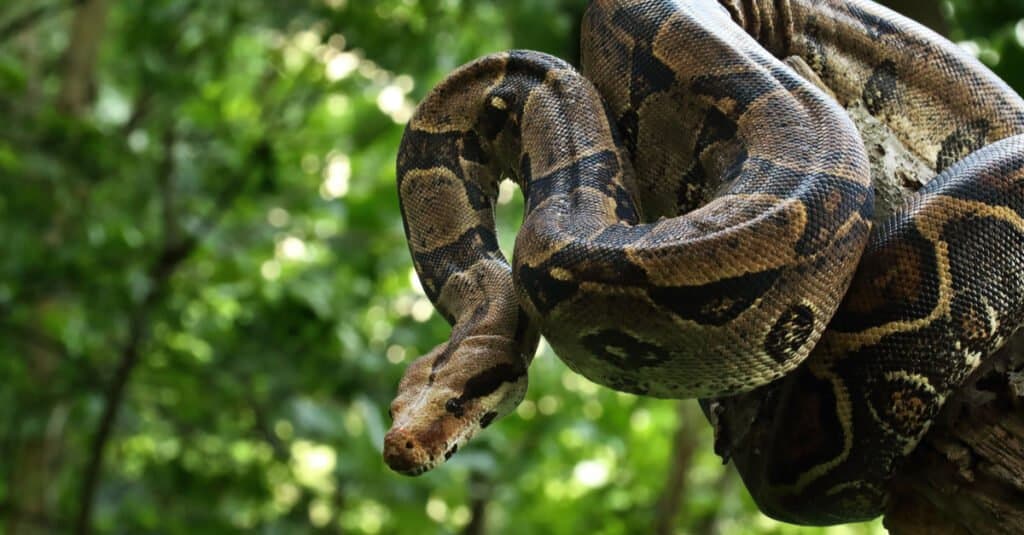
Boa constrictors, like the one that speaks to Harry Potter at the zoo, are non-venomous.
©Jan Hejda/Shutterstock.com
J.K. Rowling’s Harry Potter series includes several different snakes. For example, the first time Harry unknowingly uses his magical powers, he accidentally releases a boa constrictor from its enclosure at the zoo. Harry later discovers that he also speaks Parseltongue and can understand when snakes speak to him.
However, Harry is not the only wizard that talks to snakes. In fact, many Parseltongue-speaking wizards once belonged to the house of Slytherin at the famous “Hogwarts School of Witchcraft and Wizardry.” Slytherin’s house emblem depicts a snake encircled by silver and green. Even the name of this house, “Slytherin,” calls to mind the “slithering” movements of a snake. Lord Voldemort, the looming antagonist of the Harry Potter series, belonged to Slytherin during his time at Hogwarts. He also speaks Parseltongue and appears to be quite fond of snakes.
20. The Dangerous Snakes of Harry Potter
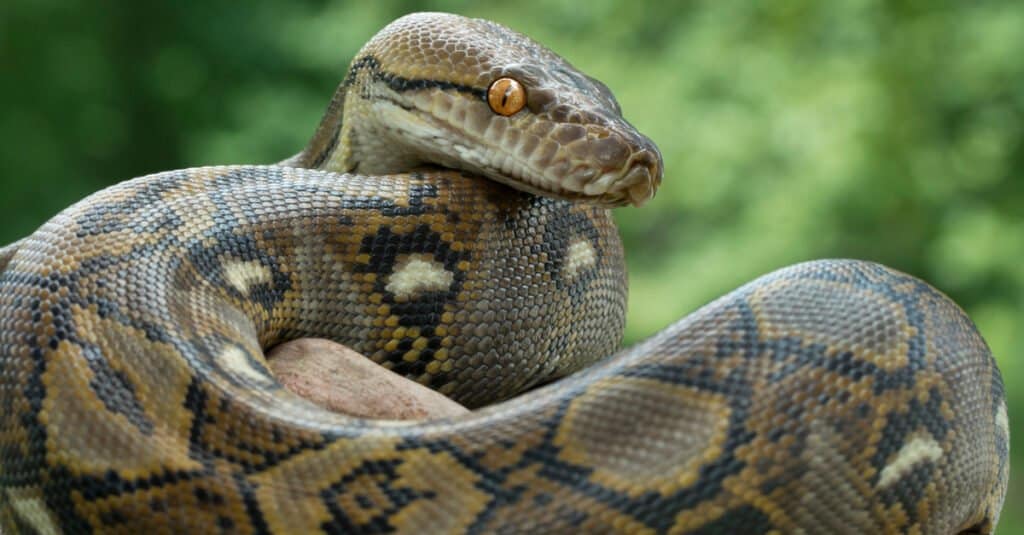
Pythons are huge, while vipers have lethal venom. Voldemort’s snake, Nagini, is a combination of the two.
©Mark_Kostich/Shutterstock.com
While the boa constrictor Harry released from the zoo was friendly, some of the other snakes in the world of Harry Potter are extremely dangerous. In Harry Potter and the Chamber of Secrets, Harry discovers the monstrous “Serpent of Slytherin”. This great beast is a giant Basilisk snake that is terrorizing the students of Hogwarts. Like the Gorgon Medusa from Greek mythology, the Basilisk could kill with just a single look. After Harry defeats the basilisk, he uses its poisonous venom to destroy one of Voldemort’s seven Horcruxes.
Voldemort had split his soul into these seven Horcrux pieces so that if his mortal body was destroyed, he could still live on. The most infamous snake in the world of Harry Potter, also happens to be one of these Horcruxes. When Voldemort was in Albania, he imbued a portion of his soul into his beloved giant python-viper hybrid pet, Nagini, transforming her into one of his final Horcrux pieces. The snake’s name, “Nagini,” actually refers to the Nāga from Hindu tradition (“Nagini” is a female Nāga).
The photo featured at the top of this post is © Michaela Warthen/Shutterstock.com
Discover the "Monster" Snake 5X Bigger than an Anaconda
Every day A-Z Animals sends out some of the most incredible facts in the world from our free newsletter. Want to discover the 10 most beautiful snakes in the world, a "snake island" where you're never more than 3 feet from danger, or a "monster" snake 5X larger than an anaconda? Then sign up right now and you'll start receiving our daily newsletter absolutely free.
Thank you for reading! Have some feedback for us? Contact the AZ Animals editorial team.







